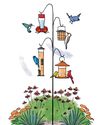試す 金 - 無料
Using Their Senses
Birds & Bloom
|October/November 2018
Discover the fascinating ways birds survivethrough sight, sound, taste, touch and smell.

FINCHES, SPARROWS AND CARDINALS are happily filling up at your backyard feeders. All of a sudden, they quickly fly away, diving into the bushes. Less than a minute later, a hawk swoops through the yard. How did the songbirds know the hawk was coming? Did they smell, or maybe hear, it? To figure this out, it helps to know more about the senses that birds use to experience the world around them.

Bird’s-Eye View
The term “eagle-eyed” for sharp vision is no accident. Nearly all birds see at least two or three times as much detail as humans, making them able to spot food— or approaching predators—that much farther away. Most birds have excellent color vision, too. Night birds like owls may have a biological trade-off: They see very well in dim light, but their perception of colors may not be as good.
Another advantage birds have is seeing ultraviolet light. To humans, male and female northern mockingbirds look exactly the same—but birds are able to tell the difference because the two have different ultraviolet markings.
このストーリーは、Birds & Bloom の October/November 2018 版からのものです。
Magzter GOLD を購読すると、厳選された何千ものプレミアム記事や、10,000 以上の雑誌や新聞にアクセスできます。
すでに購読者ですか? サインイン
Birds & Bloom からのその他のストーリー

Birds & Blooms
Better Off with Bats
Rethink the unsung heroes of the night and why you should support them
2 mins
October / November 2025

Birds & Blooms
Late Bloomers to Love
Keep garden colors going strong with fall perennials
3 mins
October / November 2025

Birds & Blooms
IN THE COMPANY OF OWLS
On any given morning, you'll find A.J. Berard trekking through the woods and mountains of Montana with a 45-pound pack and his Siberian huskies.
3 mins
October / November 2025

Birds & Blooms
Tree TLC
Discover tips for planting and tending to trees, from the roots up
2 mins
October / November 2025

Birds & Blooms
EASY. BREEZY Black-Eyed Susans
Planting rudbeckia, with petals aglow in honeyed yellow, fiery orange and velvety burgundy, is like sprinkling sunshine throughout the garden.
3 mins
October / November 2025

Birds & Blooms
Social and Adaptable
Find out how the house finch became a backyard regular
1 mins
October / November 2025

Birds & Blooms
Tales from the UNDERSTORY
The dense forest floor is the perfect setting to nest and forage
3 mins
October / November 2025
Birds & Blooms
Tracking Tiny Travelers
Small, numbered rings reveal the secrets of hummingbird migration
2 mins
June/July 2025

Birds & Blooms
The Dirt on Millicompost
Learn how to use millipedes to increase soil health
2 mins
June/July 2025

Birds & Blooms
THE PERFECT PAIRING
Learn the best ways to use an abundance of blooms to attract more birds and beautify your feeder space
3 mins
June/July 2025
Translate
Change font size

